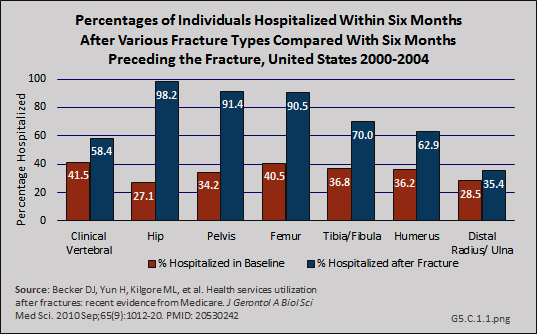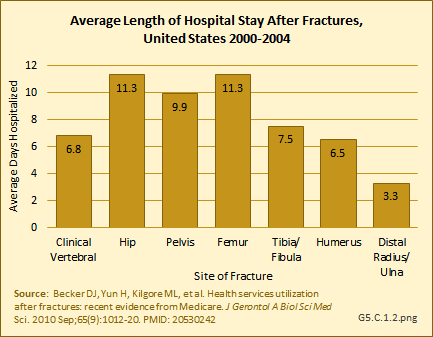

While the incidence of hip fracture appears to have declined overall since the mid 1990s, as discussed in a previous section [1], hospital discharges from the MEPS database related to osteoporosis were 44% greater in 2009 to 2011 than they were in the years from 1996 to 1998. Recent years, however, have shown a decline after peaking in 2001 to 2003. (Reference Table 10.2 PDF [2] CSV [3]) This increase in hospitalizations likely reflects the increase in older population cohorts as the Boomer generation enters the prime years for fracture incidence.
In a study among Medicare beneficiaries, the 65 years and older population, experiencing hip fractures in the years 2000 to 2004, 98.2% were hospitalized in the six months following the fracture compared to 27.1% hospitalized at least once in the prior six months for other reasons.1 Thus, hip fractures were associated with a 71% increase in the probability of being hospitalized. The average length of stay for hip and upper leg (femur) fractures was more than 11 days. (Reference Tables 5.3 PDF [4] CSV [5] and 5.4 PDF [6] CSV [7])


Using recent 2011 data from the NIS hospital discharge database, an average hospital stay of 5.5 days was reported for people age 50 years and older with a primary (first) diagnosis of fragility fracture. While it might be assumed the inclusion of younger-age patients could account for this difference from the earlier study, age was not a factor in length of stay. Sex was a more significant factor, with males staying nearly a day longer than females. With the exception of wrist and arm fractures, site of the fracture was also not a factor. (Reference Table 5.5 PDF [8] CSV [9])

Links:
[1] http://www.boneandjointburden.org/2014-report/vb3/hip-fracture-trends
[2] https://bmus.latticegroup.com/docs/T10003.2.pdf
[3] https://bmus.latticegroup.com/docs/T10003.2.csv
[4] https://bmus.latticegroup.com/docs/T5.3.pdf
[5] https://bmus.latticegroup.com/docs/T5.3.csv
[6] https://bmus.latticegroup.com/docs/T5.4.pdf
[7] https://bmus.latticegroup.com/docs/T5.4.csv
[8] https://bmus.latticegroup.com/docs/T5.5.pdf
[9] https://bmus.latticegroup.com/docs/T5.5.csv